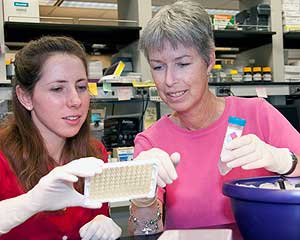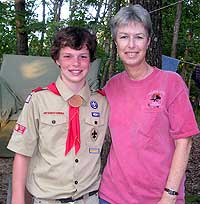To children in her son Greg’s school, Anne Fagan is known as “the brain lady.”

“I love getting kids fired up about the brain,” says Fagan, Ph.D., research associate professor of neurology. “I’ll go to Greg’s school to talk about the brain, and I’ll bring actual brains with me. It’s an innately interesting topic, and they’re fascinated by it.”
Fagan studies Alzheimer’s disease in the laboratory of David Holtzman, M.D., the Andrew B. and Gretchen P. Jones Professor and head of Neurology. She also is an investigator at the Alzheimer’s Disease Research Center (ADRC).
Fagan remembers the exact moment she became hooked on the brain: She was a junior in high school, and her physiology teacher assigned a term paper on the “biochemistry of madness.”
“That was my first introduction to the concept that brain chemicals and neurons actually influence how you feel and think, not just how you move and have senses,” she says. “I just thought, ‘How cool is that?'”
Fagan also knew one other thing early in life: Family would come first for her.
“When I say that, I don’t mean that I would abandon my work because I love what I do, and it’s very important to me,” she says. “But in the end, relationships are what hold me together. If I don’t have good family and friend relationships, then the rest of my life is meaningless.”
‘Coastal gal’ to Midwest
Fagan grew up in Marion, Mass., on Cape Cod. She earned a doctorate in neuroscience at the University of California, San Diego, under the mentorship of Fred H. Gage, Ph.D., professor of biology at the Laboratory of Genetics at the Salk Institute.
“Anne is filled with energy, very bright, dedicated and extremely hardworking,” Gage says. “She’s also great fun to be around — she’s very, very upbeat.”
Gage says that Fagan left his lab 17 years ago, but he and others in his lab stay in touch with her.
“She’s had a long-lasting impact on my lab, and we continue to follow her career with great joy,” he says.
In Gage’s lab, Fagan studied neurotrophins, nerve cell growth factors that had just come to the attention of scientists. One neurotrophin was connected to the cholinergic system, a brain system hit particularly hard by Alzheimer’s disease. Through this connection and the research collaborations it inspired, Fagan came to know Holtzman, who was then studying Alzheimer’s disease at the University of California, San Francisco.
In 1995, Holtzman, in the process of moving to Washington University to establish his own lab, asked Fagan to join his research team.
“Before I saw all the wonderful things Washington University had to offer, he had to sell me on moving to St. Louis,” Fagan says. “I was a coastal gal, and St. Louis was just a place that I was always flying over to get to where I really wanted to be.
“I was such a snob, but I love it here now,” she says, laughing.
Catching Alzheimer’s early
At Washington University, Fagan began her research career with studies of apolipoprotein E (ApoE). Variations in the gene for ApoE affect Alzheimer’s risk. Through tissue culture and genetically modified mouse models, Fagan and Holtzman were instrumental in establishing the important relationship between the different forms of human ApoE and the amyloid beta 42 peptide, the key ingredient of brain plaques seen in Alzheimer’s patients. They showed that ApoE is involved in amyloid beta transport and aggregation, and that some versions of ApoE are more effective contributors to these processes than others.

One challenge of human Alzheimer’s has always been that it takes place in the brain, an area of extremely limited access. But the cerebrospinal fluid (CSF) that circulates through the brain also moves through the spinal canal and can be safely sampled via a routine procedure known as a lumbar puncture.
Fagan and her colleagues at the ADRC started studying CSF samples from research volunteers to see if they could use a variety of indicators in the CSF to diagnose Alzheimer’s before clinical symptoms start.
“The emphasis here at Washington University has always been on early-stage and preclinical detection, years or even decades before symptoms begin,” Fagan says. “When symptoms appear, Alzheimer’s has already done a great deal of damage to the brain, so we have stressed the need to find a way to start treatment before that point.”
Fagan and her collaborators have examined several factors in CSF as potential biomarkers, or indicators that correlate with the future onset of Alzheimer’s. These have included CSF levels of amyloid beta 42 peptide, which tend to go down in the CSF as amyloid builds up in the brain. For predicting which cognitively normal persons will go on to develop dementia, the most promising marker so far is the ratio of amyloid beta 42 levels to levels of tau proteins, a family of proteins associated with neurofibrillary or nerve fiber tangles in the brain that also are characteristic of Alzheimer’s disease.
In 2006, Fagan was lead author on a study where she and others at the ADRC worked with Mark Mintun, M.D., professor of radiology, of psychiatry and of neurobiology, to use medical science’s first successful amyloid imaging agent to check the predictions they were developing based on analyses of volunteers’ CSF. They found that they could use the CSF studies to predict whether imaging results would show increased amyloid in subjects’ brains.
The Annals of Neurology, which published the study, awarded Fagan and her co-authors the “Highest Impact Paper of the Year” award. The Alzheimer’s Association also recognized the paper by awarding Fagan its “Alzheimer’s Disease Neuroimaging Award, New Investigator.”
“Anne is simply an amazing person,” Holtzman says. “Trained as a basic neuroscientist, she has become one of the most respected leaders in an important area of translational science, biomarkers for Alzheimer’s disease. She’s also a great colleague, friend and teacher.”
Being the mom she wants to be
Fagan is grateful for the “outstanding” mentoring she has received from Holtzman and the opportunities that being a member of his lab gives her to “be the mom I want to be.”
|
Anne Fagan |
|
Born in: Milwaukee Favorite local performing artists: The Saint Louis Symphony Orchestra Favorite composer: Mozart Best advice for graduate students: “Ask the right questions.” Favorite restaurants to visit with son, Greg: Shogun and Longhorn Steakhouse Likes to read: Nonfiction, historical fiction and mysteries Also a fan of: The Harry Potter series |
“Sometimes I leave work after a long day, and I’ll say, ‘OK, off to my real job,'” Fagan says. “Women nod knowingly.”
Fagan has been a single parent to Greg, 12, since 2001. She says they “love to be out and about” and can often be found biking, hiking or engaging in other fun activities away from home, including both spectator sports and Greg’s many athletic activities.
“Greg is lucky; he’s a real natural athlete,” Fagan says. “I worked at sports as a kid, but it comes easy to him. He’s a good student, too. He’s a very well-rounded kid.”
As a member of the research faculty, Fagan is not formally involved in the development and implementation of medical school curricula. But she still has opportunities to give special lectures to medical students, residents and visiting scholars, and to mentor and advise young students.
“Many young women have come to me because it seems to them like I have the ideal job, successfully combining work and family, and I would have to agree: I’ve carved out a place that works for me,” Fagan says.
Fagan appreciates both the friendly, family-oriented atmosphere of St. Louis and the collegiality of the University. She found the support of both communities essential during the past year as she dealt with two major health problems.
“My heart stopped for seven minutes in 2001 at my father’s funeral, and I had to be shocked back to life,” Fagan says. “They thought it was vasospasm but couldn’t confirm it until I came back with symptoms after a ski trip in April 2008, and that led to the implantation of a cardiac defibrillator.”
Later the same year, Fagan was diagnosed with nasopharyngeal cancer, a rare and dangerous but potentially treatable form of cancer. She went through 33 rounds of “brutal” radiation treatments, two rounds of chemotherapy and three hospitalizations in as many months.
“I am happy to report that I am cancer-free today and starting to bounce back physically,” Fagan says. “Everyone has been and continues to be unbelievably supportive — Dave (Holtzman), the lab, the entire ADRC community, my family, my ‘village’ of friends and church members and Greg.”
Fagan also is grateful to her lab staff, who kept her research program going “admirably” while she was absent.
She says with a laugh that the one thing that really threw Greg for a loop was that her hair posttreatment is now gray.
“Other people like it; I’m taking votes on whether or not to keep it,” she jokes.